
21-24 (female)

55-70 (female)


Gun
The Chesapeake Bay Retriever, also referred to as “Chessies” originated from the U.S during the 19th century. This breed belongs to the UKC Gun Dog group, and the AKC Sporting Dog group. The Chessie was bred from two Newfoundland-type dogs that were found in an English shipwreck. Newfoundlands, Irish Water Spaniels, and hounds were believed to have contributed to the Chessie gene pool.
Physical Description
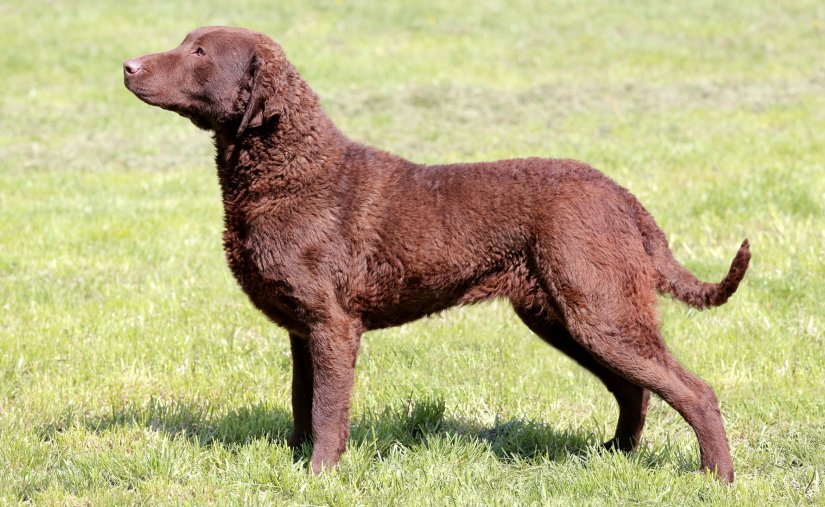
The Chesapeake Bay Retriever is a powerful, medium-sized dog breed, that is slightly longer than it is tall. With small drop ears, and magnificent amber eyes, the Chessie is taller at the loin than at the withers. The jaw is strong and broad, and can carry large game birds gently. The Chessie has a long tail that hangs low, and wonderfully webbed feet for swimming.
The coat is short, oily, and water-repellent. The Chessie has a double coat that is curly on top, yet straight on the head and legs. The undercoat is dense, and may carry slight feathering on both rump and tail. Coat color may be brown, sedge, or dead grass. The Chessie works well in frigid temperatures and adverse weather conditions.
Temperament
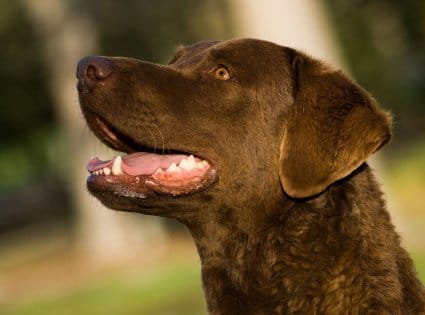
The Chessie is of outstanding character. A dignified, loyal and intelligent breed that adores family, friends and other animals. This breed is even- tempered, and loves to have a job. In fact, the Chessie, and eager worker, is passionate about all canine sporting activities, most especially water activities like dock diving.
This breed is serious, and lives to please family and friends. Because the Chessie is highly trainable and very gentle, it is recommended that positive dog training be tailored around the specific temperament of the dog. Socialization needs to start during the first 4 weeks of age. This breed loves water, and every effort should be made to allow the Chessie to swim and play in the swimming pool and beach.
Special Needs Chesapeake Bay Retriever
The Chesapeake Bay Retriever requires daily exercise, socialization, and positive dog training. The Chessie is a water dog that was bred to hunt water game in the cold, icy waters of the Chesapeake Bay during the winters. This breed is a hardy and sporty dog breed that needs to be around active pet parents or live on a large farm where he can run freely, and swim in lakes and rivers. Pet parents should consider dock diving, agility, flyball, obedience, hiking and canine surfing if living in a suburban area with a Chessie. The Chessie does best with experienced pet parents that are active and outgoing.
Possible Health Concerns
The Chesapeake Bay Retriever is a healthy dog breed, yet may be susceptible to the following health problems:
- Hip Dysplasia is the abnormal development of the hip joint in large dog breeds like the Chessie. It is generally characterized by a loose joint, and then degenerative joint disease. The Chessie should be fed a high-quality diet that is geared towards their life stage. A puppy Chessie should only be fed high-quality puppy dog food. Excessive growth, types of exercise, nutritional factors, and hereditary factors all come in to play with hip dysplasia. Ask your vet for the best nutritional advice for active dogs like the Chessie.
- Dwarfism (Chondrosdysplasia) This refers to the abnormal development of your Chessie’s bones and cartilage. This is a genetic disorder that potential Chessie parents need to test for. Symptoms to look out for include an undershot jaw, larger than normal head, crooked teeth, shorter bones, poor growth, spinal deviation, front -legged bowing, and enlarged joints. Consult with your veterinarian if your Chessie has any of these symptoms. Nutritional management helps with this condition helps!
- Entropion This is when the eyelids roll inward, and the eyelashes rub against the cornea. It is a very painful and irritating condition for dogs. This is a heritable disorder that can be surgically corrected by your veterinarian.
- Bloat or gastric dilation occurs often in larger breeds with narrow chests like the Chessie. Exercise needs to be avoided right after eating or drinking large amounts of water. Left untreated, this will usually result in death. Symptoms include dry retching, vomiting, pacing, heavy panting, and enlarged abdomen. Contact your emergency veterinarian right away even if it’s the middle of the night. This condition cannot wait to be treated, and is considered an emergency.
Exercise
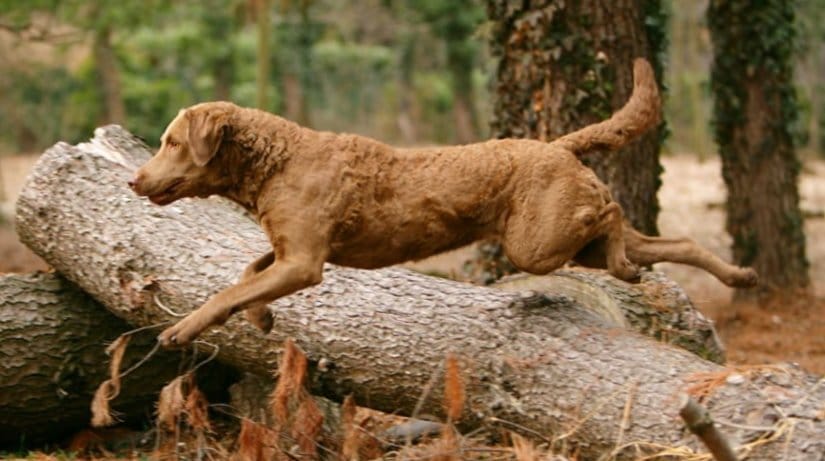
The Chesapeake Bay Retriever thrives on a consistent exercise schedule. This breed needs to run off leash, swim, play Frisbee, partake in as many canine sports possible, and be around dog people, other animals and children. The friendly Chessie is extremely sociable, and will become depressed if isolated and left alone at home for long periods of time.
The Chessie has to start with positive dog training during puppyhood, since this breed can become stubborn, or set in his ways. He is a comforting, friendly, and active dog breed that is very intelligent. That said, give the Chessie as many outdoor activities to enjoy. Additionally, the Chessie needs to be indoors during the hot summer months, and should only exercise during the early morning or evening hours, so as to keep cool and comfortable.
Nutrition
All dog breeds regardless of size and age need to be fed a high-quality diet. With so many high-quality dog food brands out there today, choosing the right one for your Chessie is easy.
Chesapeake dog parents should never underestimate the importance of high-quality, balanced nutrition for their Chesapeake Bay Retriever. Start by you assessing your Chessie’s activity level, age, breed, and any medical conditions that he or she may be prone to when selecting the best dog food. With options like bison, duck, venison, quail, wild boar, lamb, salmon and turkey, dog food brands offer unique and unusual protein sources that are healthy for active dogs. Consult with your veterinarian if your Chessie has possible food allergies.
Some dog food formulas contain probiotics, salmon oil, and guaranteed calcium and phosphorus levels to help support healthy development of your Chessie’s pup’s teeth and bones.
For older dogs, look for recipes that offer glucosamine and chondroitin for hip and joint wellness. The protein options can include turkey and chickpea stew, salmon and chickpea stew, and a chicken with chickpea with no artificial flavors, corn, or soy in the ingredients.
- There is no “best diet.” Dogs are individuals. A diet that works for one Chessie may not be the best for another. Age, energy level and individual medical concerns play a large role for each individual dog.
- The recommended guidelines on bags often contain more calories than dogs need. Unless your Chessie a very energetic (and intact) animal, veterinarians will usually recommend feeding the lower end of the recommendation.
- Feed a complete and balanced food for the appropriate life stage of your Chessie. Always consult with your veterinarian if your Chessie develops food allergies, and needs a change of diet. Some Chessies may have special needs like a weakened immune system. Adding supplements is always a good idea.
Grooming
The Chesapeake Bay Retriever is a shorthaired dog breed that has a soft undercoat, and a slightly rough outercoat. This breed needs to be brushed every day, and bathed regularly. If your Chessie has dry skin, use a natural shampoo that soothes and heals. That said, nails need to be trimmed when needed, and ears cleaned. Overgrown nails can splay toes, and cause pain.
Your Chessie is going to need regular dental care. Dogs develop gum disease from tartar buildup. Your Chessie does best with regular dental checkups from your veterinarian, and a twice yearly professional dental cleaning.
Adopting a Chesapeake Bay Retriever
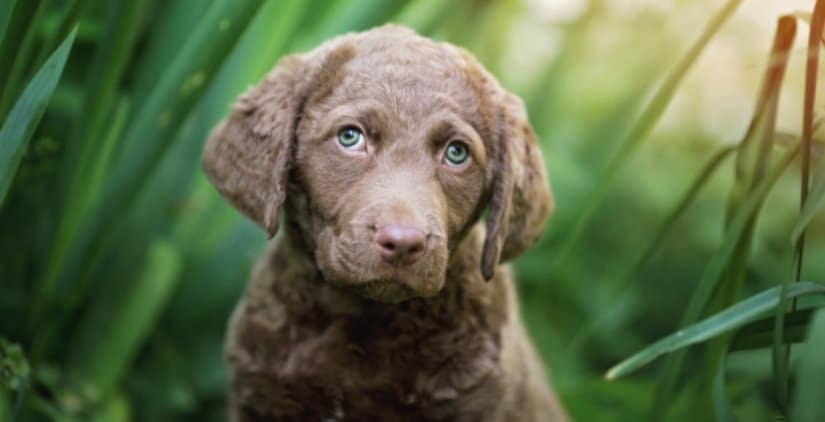
Gun dogs like the Chesapeake Bay Retriever make excellent companions. They are loyal, fun, active, and love children. Gun dogs were bred to accompany hunters out hunting for large game birds. Additionally, this breed is used to being around people, and was bred to be around people. This breed loves being outdoors, and is a very sporty dog breed that enjoys hiking trips, and going camping with the family.
Potential pet parents to the Chessie should be active, and love the outdoors come rain or shine. These gentle and wonderful dogs are so easygoing, but have a strong chase instinct. By providing positive puppy training classes and early socialization skills, you can teach your Chessie not to chase small animals, and to come back to you when called. Always opt for dog adoption as opposed to purchasing from a pet store or online. Do your research on your dog breed, and as usual spend time with your potential Chessie prior to adopting and bringing him home.
History
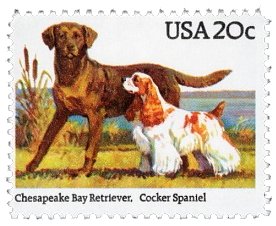
By 1884 when the AKC was formed, a Chessie type breed was around. Hunters in Chesapeake Bay formed a retriever well for duck hunting in the frigid waters of the bay. Because the Chessie has a double coat that is insulating and waterproof, as well as large webbed feet, it allowed this breed to hunt ducks very well. The Chessie was recognized as a breed by the end of the 19th century.
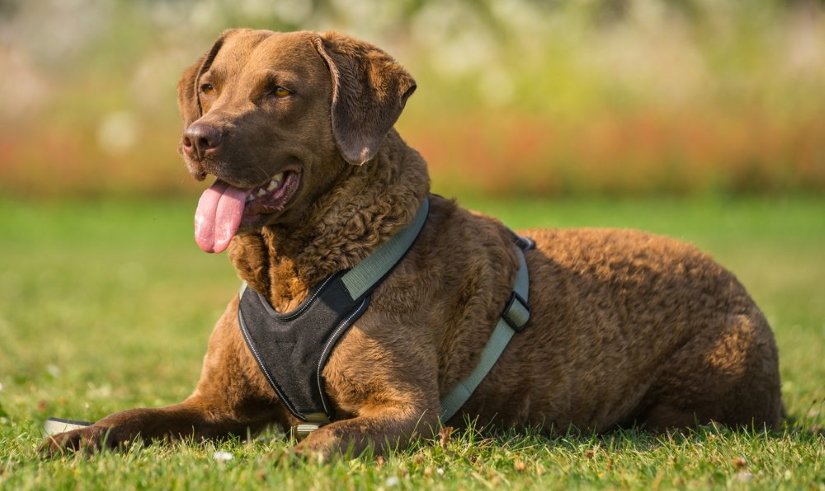
I loved my Chessie, he was by far the smartest dog I have ever had. He was beautiful and trained to the teeth, he would do anything I asked of him happily. He was great with my small children, they lived him. We live on the Columbia river, Jess, was in hog heaven. He swam in that river any time of year and I really do think he liked it best when it was cold. The first duck I ever shot was the first duck he retrieved, aside from the decoys, that is. He was so proud of himself, puffed up and prancing. I really miss, Columbia River Jess. And I would love to have another one
When can they start swim? Which older?
The Chesapeake Bay Retriever loves nothing more than swimming, and going for long walks. They’ll spend as much time as you let them in the water if you let them. With regards to the perfect age, it’s best to first take your pup to the beach and let him get his paws wet. You can gradually get your Chessie puppy used to the water between two to five months of age. During this stage your puppy will be able to start “paddling” in very shallow water. Keep in mind that there are a few dog breeds that cannot swim like the Bulldog, and those with large heavy chests and short muzzles.
Additionally, some dogs may be apprehensive of water, and you’ll need to encourage your dog to swim, though this really doesn’t apply to the Chessie very much. Safety is key, and you’ll always need to protect your dog from accidents, and encourage the use of a doggie life vest when out boating. If your Chessie is nervous and refuses to get in the water, you’ll have to keep him or her cool and under a shady spot to prevent heatstroke. Your Chesapeake Bay Retriever must also always have access to plenty of fresh drinking water. As usual, make sure to bring along all the necessary training gear like leashes, extra collars, and doggie sunscreen.
I want to Adopting a Chesapeake Bay Retriever